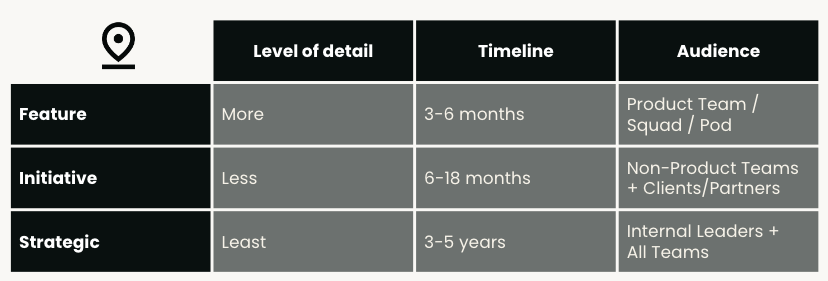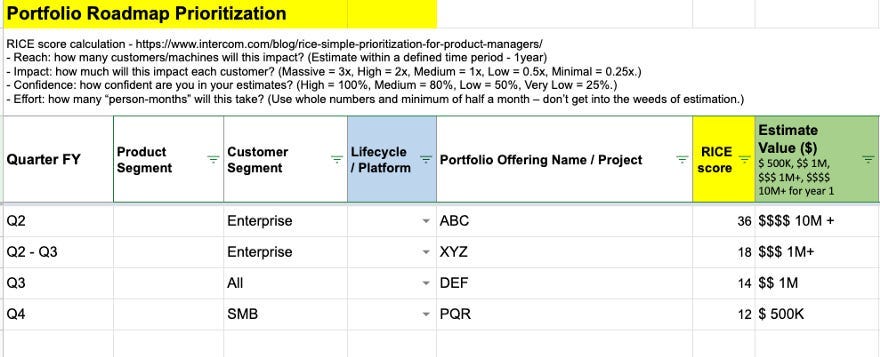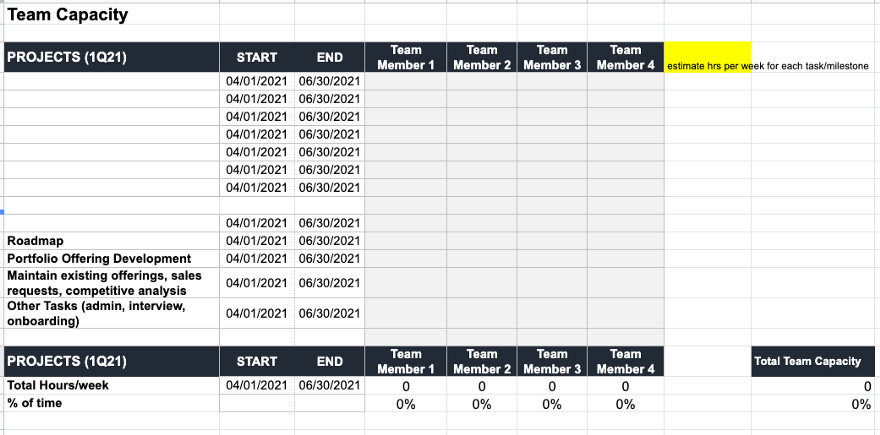What is included in this Playbook?
Product Roadmap Types
Introduction
Challenge
Solution
Step 1: RICE Scoring
Step 2: Team Capacity
Step 3: RAPID Framework
Resources
Product Roadmap Types
1. Feature-Level Roadmap:
Focus: Granular details of specific features, functionalities, and their intended delivery.
Purpose: Provides a detailed execution plan for the development team, ensuring everyone is aligned on what needs to be built and when. Facilitates sprint planning and task management.
2. Initiative-Level Roadmap:
Focus: Higher-level projects, epics, or strategic themes that deliver significant customer or business value. Features are often grouped under these initiatives.
Purpose: Communicates the strategic direction of the product and how larger investments are being made. Helps align different teams and stakeholders around key priorities and expected outcomes.
3. Strategic Roadmap:
Focus: Long-term vision, strategic themes, and high-level outcomes the product aims to achieve, often tied to business goals.
Purpose: Communicates the overarching product vision and strategy, aligns the organization on the long-term direction, and informs high-level investment decisions.
Introduction
Prioritizing a portfolio roadmap aligns product development with business strategy. It involves making tough choices about which projects to pursue and which to defer, ensuring that resources are allocated effectively to maximize value delivery.
This playbook provides a structured approach to portfolio roadmap prioritization, combining the RICE scoring framework, team capacity planning, and the RAPID decision-making process.
Challenge
Product teams often face the challenge of having more project requests than available resources. This can lead to:
Overburdened teams: Trying to do too much at once, leading to burnout and decreased productivity.
Lack of focus: Spreading resources too thin, resulting in diluted efforts and slower progress on key initiatives.
Misalignment: Working on projects that don't align with the overall business strategy, reducing their impact.
Stakeholder dissatisfaction: Difficulty in managing expectations and delivering on all requests, leading to frustration.
Solution
This playbook outlines a three-step process to address these challenges and effectively prioritize your portfolio roadmap.
Step 1: RICE Scoring
RICE scoring is a prioritization framework that helps evaluate project initiatives based on four factors:
Reach: How many users will this project impact within a specific timeframe? (e.g., users per quarter)
Impact: How much will this project impact each user? (Use a scoring scale, e.g., 5 = massive impact, 1 = low impact)
Confidence: How confident are you in your estimates for Reach and Impact? (Express as a percentage, e.g., 100% = high confidence, 50% = low confidence)
Effort: How much effort will this project require? (Estimate in person-months or story points)
The RICE score is calculated as:
RICE Score = (Reach x Impact x Confidence) / Effort
Portfolio Roadmap Prioritization by Estimate Value and RICE score
RICE score calculation
Scenario:
Let's say you're evaluating three projects:
Project A: Reach = 1000 users, Impact = 3, Confidence = 80%, Effort = 2 person-months
RICE Score = (1000 x 3 x 0.80) / 2 = 1200
Project B: Reach = 500 users, Impact = 5, Confidence = 60%, Effort = 1 person-month
RICE Score = (500 x 5 x 0.60) / 1 = 1500
Project C: Reach = 2000 users, Impact = 2, Confidence = 90%, Effort = 3 person-months
RICE Score = (2000 x 2 x 0.90) / 3 = 1200
In this case, Project B has the highest RICE score, suggesting it offers the most value relative to the effort required.
Real-World Example:
Context: As the product team at a SaaS company, we were struggling to prioritize features for new customers. We had numerous ideas, but limited development resources.
Application: We used RICE scoring to evaluate each feature idea. We estimated that feature X would reach 80% of new users, have a "high" impact on conversion (scored as 4), 90% confident in these estimates, and it would take 3 weeks (0.75 person-months) to implement.
Result: The RICE scores helped the team objectively compare different features and prioritize those that would deliver the most value to new users with the least amount of effort. We prioritized a feature that streamlined the workflow process, which led to increase in conversions.
Step 2: Team Capacity
Once we have RICE scores for our projects, it's crucial to assess our team's capacity to deliver them. This involves:
Estimate effort: Work with our engineering and development team to estimate the effort required for each project in a consistent unit (e.g., person-weeks, story points).
Determine team capacity: Calculate our team's available capacity for the planning period (e.g., quarter). Consider factors like team size, vacations, and other commitments. Aim for a sustainable utilization rate (e.g., 80%) to allow for unexpected tasks and prevent burnout.
Match projects to capacity: Compare the total estimated effort of prioritized projects with the team's capacity. Adjust the roadmap as needed by moving projects to future quarters or removing them from the portfolio.
Team Capacity by Projects and Quarter
Team Member Projects
Scenario
Our team has a capacity of 100 person-weeks for the next quarter.
The top projects from our RICE scoring exercise have a total estimated effort of 120 person-weeks.
We need to either increase the team's capacity or move some projects to the next quarter.
Real-World Example:
Context: As a product team responsible for services, support and delivery, we were missing deadlines. We realized we were overcommitting development.
Application: We started tracking the actual time spent on projects and compared to the initial estimates. And factored in time for fixes, maintenance, and unplanned tasks.
Result: By accurately assessing the team's capacity, we were able to create a more realistic roadmap. We reduced the number of projects committed to each quarter, which led to improved team morale, fewer missed deadlines, and increase in on-time delivery.
Step 3: RAPID Framework
The RAPID framework is a decision-making tool that clarifies roles and responsibilities in the prioritization process:
Recommend: Who gathers information and proposes a course of action?
Agree: Who makes the final decision?
Perform: Who carries out the actions?
Input: Who provides valuable information or perspectives?
Decide: Who approves the decision?
For a portfolio roadmap prioritization decision:
Recommend: Product Management
Agree: VP of Product
Perform: Engineering and Development
Input: Engineering, Marketing, Sales, Customer Support
Decide: General Manager / Head of BU
Real-World Example:
Context: As a team, we struggled with slow decision-making on the product roadmap. Stakeholders often disagreed on priorities, leading to delays and frustration.
Application: We implemented the RAPID framework to clarify roles. Product management is responsible for recommending priorities based on data (including RICE scores), the GM made the final decision, and a cross-functional committee provided input.
Result: The RAPID framework streamlined our decision-making process. Decisions that used to take weeks now took days. This improved our ability to respond to market changes and deliver value to customers more quickly.
Resources
Lessons learnt on the how, when and where to bring prioritization for the portfolio roadmap with RICE scoring, team capacity and RAPID.
Portfolio Roadmap Prioritization | RICE Scoring | Team Capacity [Google Sheet]
RICE: Simple prioritization for product managers - Intercom: https://www.intercom.com/blog/rice-simple-prioritization-for-product-managers/


















